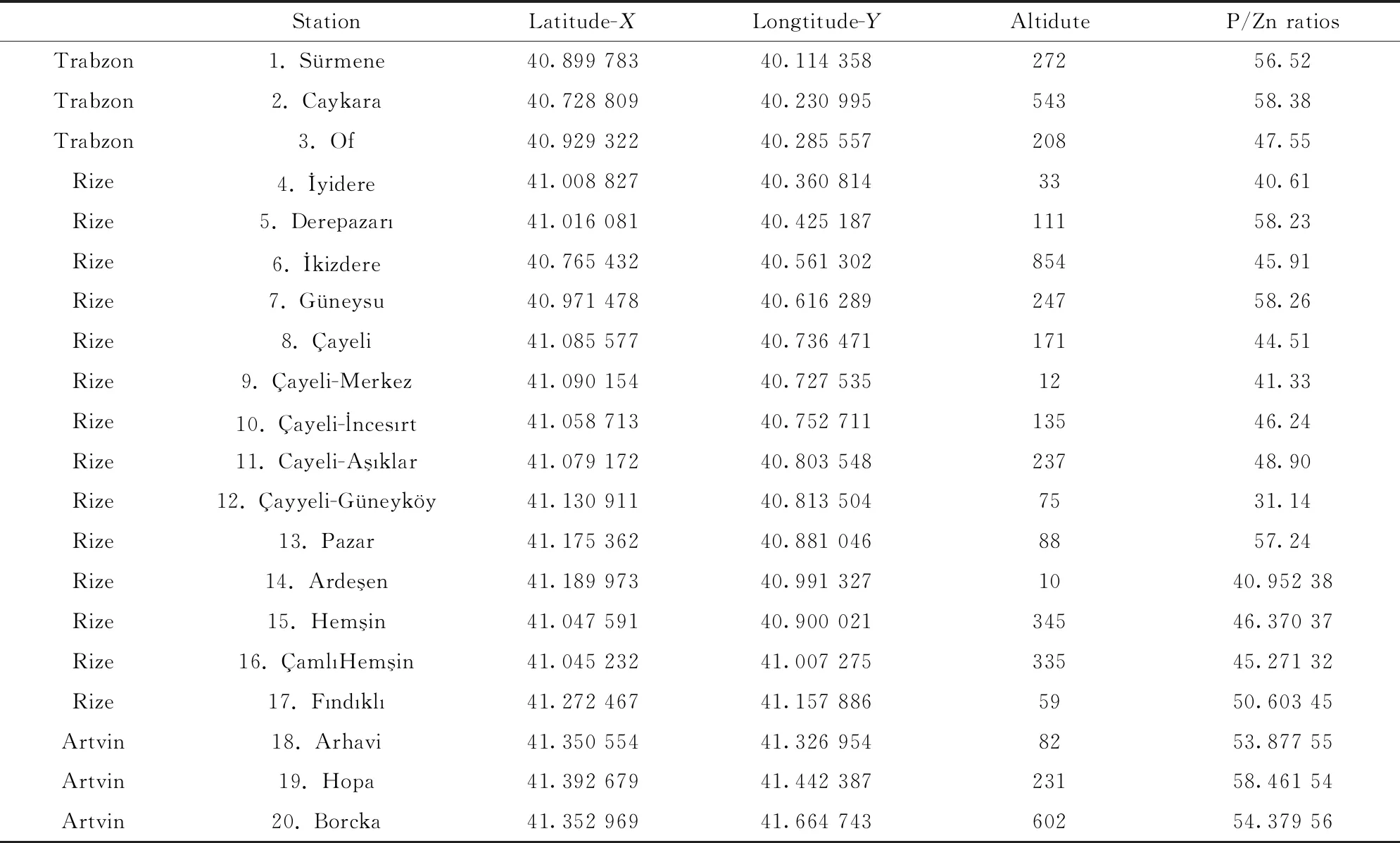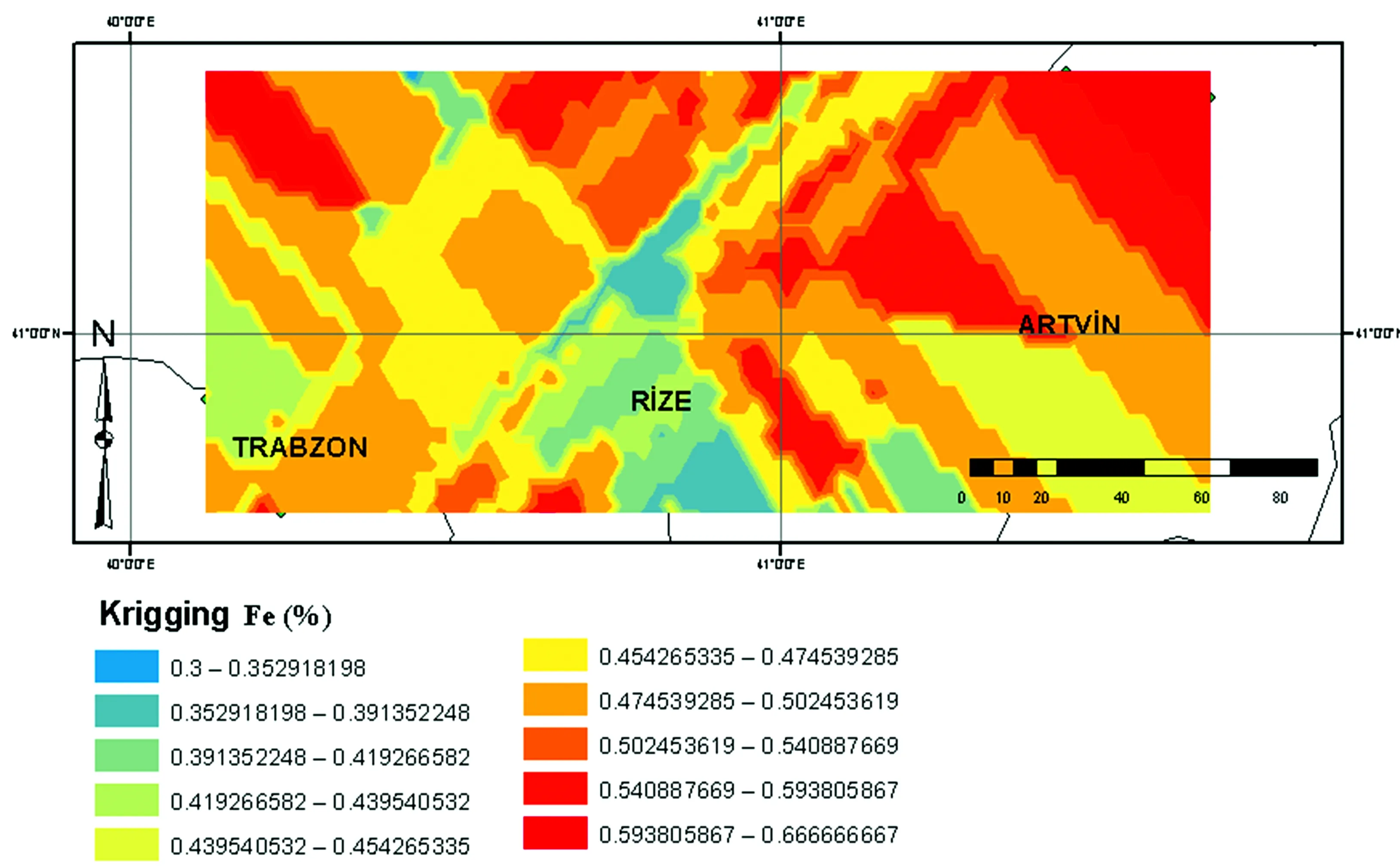Elemental Analysis of Tea Leaves (Camellia Sinensis) and Their Own Soils at Eastern Black Sea Region in Turkey
2020-05-07CananAksoyHaticeKabaoglukhanApaydnAzizSafiEnginTrasoglu
Canan Aksoy, Hatice Kabaoglu, Gökhan Apaydn, Aziz Safi, Engin Trasoglu
1. Dept. of Electronics and Communication Engineering, Karadeniz Technical University, Of, Trabzon, Turkey 2. Dept. of Computer Engineering, Gazi University, Ankara, Turkey 3. Department of Physics, Karadeniz Technical University, 61080 Trabzon, Turkey
Abstract People consume tea brewed from the leaves of the Camellia sinensis plant for about 50 centuries. Health benefits of the tea have been investigated for about three decades. Especially green tea shows antitoxic and lots of properties with its determined ingredients. Turkey is not only the one of the best consumer and but also good producer of the tea as being 5th producer all over the world. It grows eastern region of the Turkey and high quality tea is imported and exported. To have quality tea, grooving soils are also crucial. In the current research, Tea leaves and their own grown soils were collected from 20 stations where the most tea producer cities as Trabzon, Rize and Artvin tea fields of the eastern of Black Sea Region in Turkey. The cultivated tea and their own grown soil samples were analysed by using EDXRF Spectrometry. In the soil samples, the elements Mg, Al, Si, P, S, K, Ca, Ti, V, Cr, Mn, Fe, Ni, Cu, Zn, Sr, Ba, Pb on percent level and the elements Mg, Al, Si, P, Cl, K, Ca, Ti, Mn, Fe, Ni, Cu, Zn and Sr in the tea leaves were detected by using SKRAY 3600-EDXRF.and also the obtained data were evaluated with the Kriging interpolation of geostatistical method. Element content were investigated in the soil and tea samples according to the geological situations and also the relation of elemental difference between the tea and the own grown soil. Pb/Zn ratio was also anaysed in the samples.
Keywords Eastern of Black Sea; EDXRF; Tea leaves; Soils
Introduction
Tea, biological name iscamelliasinensisfrom theaceae family, is most popular beverage worldwide may be after water with full of health benefits such as being antioxidant and tantimicrobial, anticarcinogenic and anti-inflammatory[1-3]. Turkey is among the major tea growers in the country are grown only in the eastern Black Sea region of Turkey. Turkey is the fifth in an annual amount of tea grown in the world. It is grown in mostly eastern of Black Sea coastline from Giresun to Georgia in Turkey. Tea is a cultivated plant growing in humid climates. The most productive city is Rize where has 100% of Turkey’s total tea production are obtained from this region. The harwest area is quite narrow and harwest time is four times in a year at 3 months periods.
The fact that tea is a consumed drink, especially the Turkish people, has made it an important issue to focus on the substances contained in the tea and its effects on human health. Tea, especially in China, is used for therapeutic purposes. Examples of diseases used for the treatment of tea include asthma, chest angina, peripheral vascular disease, and coronary artery disease. The tea is effective against the smell of breath and also shows antioxidant effect[3-9]. Due to such crucial benefits of tea, it is needed to have knowledge of nutrients and element content in the tea. For this many techniques have been used such as atomic absorption spectroscopy (AAS)[9], inductively coupled plasma atomic emission spectrometry (ICPAES)[10], inductively coupled plasma mass spectrometry (ICP-MS)[11], capillary electrophoresis[12], and total reflection X-ray fluorescence spectrometry (TR-XRF)[13-14].
In this study,tea leaves and their soils were collected from eastern of Black Sea cities Trabzon Rize and Artvin from 20 station to determine element levels of both soil and tea samples by using Energy Dispersive X-ray fluorescence spectrometry (ED-XRF) which is non-destructive for samples during the measurement.
1 Materials and Methods
The tea leaves and the soil samples were harvested at the beginning of spring from the areas where teas are grown from Trabzon, Rize and Artvin in Eastern Black Sea region of Turkey. The samples were dried at the temperature at 70 ℃ in a Heraeus oven. After grinding the powder samples, the powder samples were sieved through a 400 mesh sieve to reduce the particle size and stirred 20 minutes to obtain a good mixture for sampling. The samples were pressed under the pressure 20 ton by using boric acid stabilizer.
1.1 EDXRF Measurement
The elemental concentration of the tea leaves and the soils from the same station were measured with a Sky Ray EDX3600B spectrometer having an Oxford Rh anode X-Heat tube. The spectrometer is manufactured in Germany and has SDD at an energy resolution of (145±5) eV. This spectrometer has a sensitivity of 0.05% in the elements from sodium to uranium in the analytical range of 99.999 ppm. In addition, 24 elements can be analyzed at the same time.
Standardization of the samples was done with Panalytical AXIOS advanced WDXRF. IQ + program was used in the standardization study. This program gives semi-quantitative results with sensitivity of 90%~95% for all samples. The standard curves were drawn on the EDX3600B spectrometer using standards derived from the IO+ program and loaded into the system. The concentrations of the samples were determined using these standard curves.
1.2 Geostatistical Analysis
The results were evaluated, considering Latitude, Longtitude and Altitude data of the sampling area, by using ordinary Kriging interpolation of geostatistical method which is the most common method used in simulation for spatial data and it is also minimizes the variance of the estimation error. For analyzing data for mapping software QSIS- map program and WEKA software tools were used.
2 Results and Discussion
The tea leaves and the soils were collected from eastern Black Sea cities Rize, Trabzon, Artvin and their counties in Turkey. The determined elements were detected in the tea are Na, Mg, Al, P, S, K, Ca, Fe, Cu, Sr, Mn which are some essential minerals for human health as they are activators for enzyme-catalysing reactions[15]. The soil elements were detected Mg, Al, Si, P, K, Ca, Ti, Fe, Sr, V, Cr, Mn, Rb in the cabbage collected region.
The elemental contents were worked out by using EDXRF3600 Spectrometer and the statistical analysis were done with the Arcmap program to determinate estimated element distribution of working region. Mostly abundant elements sampling stations as numbered are shown in Table 1 with the geographical properties as latitude, longitude and altitude which are important parameters for plant grown.
In the plant one of the important parameter is (P / Zn)ratio. P / Zn ratio in plants; if (P / Zn)<50, P is deficient , if (P / Zn)<50~200, Zn is sufficient , if (P / Zn)>200 , Zn is deficient.The reason for the lack of Zn element is usually due to the excess phosphorus. The low level of useful zinc in the soil is related to low soil temperature, the presence of free lime, low organic matter, high phosphorus level. High levels of useful phosphorus in the soil, zinc in the medium level of the soil, at low temperatures, zinc deficiency in the plant causes, but at high temperatures, this deficiency is not seen. Zinc deficiency also prevents the leaves from taking their normal size and causes their shapes to change. In the case of zinc deficiency, the leaf system of the tree becomes sparse and the knot spacing becomes shorter. The efficiency of trees exposed to zinc deficiency is also decreasing[19]. In our samples P/Zn ratios are Sufficient for Sürmene, Çaykara, Derepazar, Güneysu, Pazar, Fndkl, Arhavi, Hopa, Borçka but others (P/Zn) level is lover than 50% which are shown in bold in Table 1.
In Table 2, Mg, Al, Si, P, S, K, Ca, Ti, V, Mn, Fe elements on percent level, in the soil sample are presented. In Table 3 Mg, Al, Si, P, Cl, K, Ca, Ti, Mn, Fe in the tea leaves are presented. Al, Ca, K, Mg, Mn, Na, P and S are major constituents in tea[18]and the elements in teas are Ni, Cr, Cu, Zn, Sr, Ba,Pb even they are below the detection limit.
Besides the graphical comparison the statistical mapping by used krigging method is also presented in Figure 1( a—c) with the numbered station and colored maps of Fe and Mg element distribution , from dark blue (less dense) to red (denser).

Table 1 The geographical properties of the station of the harvested tea samples

Table 2 The soils of the tea collected stations

Fig.1(a) The numbered map of the sampling areaby designing Krigging Method

Fig.1(b) The numbered map of the sampling areaby designing Krigging Method

Fig.1(c) Interpolation maps of Mg element distribution by designing Krigging Method
The Mg, Mn, Fe levels are quite different for Çamlhemin, Çayeli,Ardeen and Arhavi towns; Mg Level is higher in Çamlhemin, Çayeli,Ardeen and Arhavi towns have higher level for Mn content, Hopa and Borçka have higher Fe content as seen in Table 3. due to the fertilizing method, rain fall in m2, altitude and soil type shows difference for every station. Fertilizing specially Ammonium Sulfate included fertilizers increased the soil acidity which induce the adsorption of the elements easier by the plants[16]. The increase in metal content of soil has a great influence for determining the soil quality and on human health through the plants growing on it[17]Tea plant intends to grow in the humid and acidic soils.

Table 3 Elemental distribution in the tea samples
3 Conclusion
The tea leaves and their soils were collected from 20 stations in Rize, Trabzon, Artvin towns from tea fields, one of the best tea producer, of eastern of Black Sea region in Turkey. The elemental analysis were worked out by using EDXRF spectrometer and obtained results were evaluated by Kriging interpolation of geostatistical method that is one of the statistical interpolation method, to get elemental distribution in tea according to sampling stations. It seems that besides the other spectroscopy techniques EDXRF is also give significant results for soil and plant researcher as there is no necessity for a solution during the sample preparation, the samples can be directly measured if the need is only learning element content of element composition in the plant. In this study dried and grinded tea leaves and grinded soils measured by EDXRF Technique. According to the results the tea quality quite good if we consider the P/Zn ratio in tea leaves.
